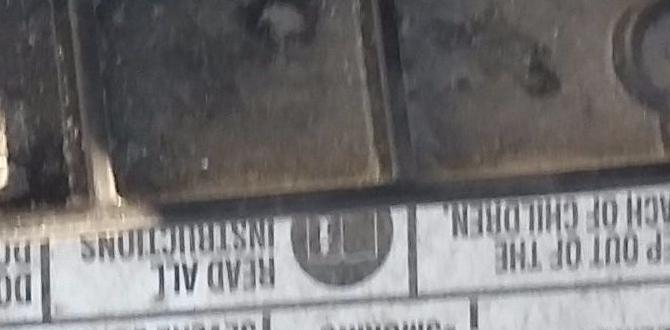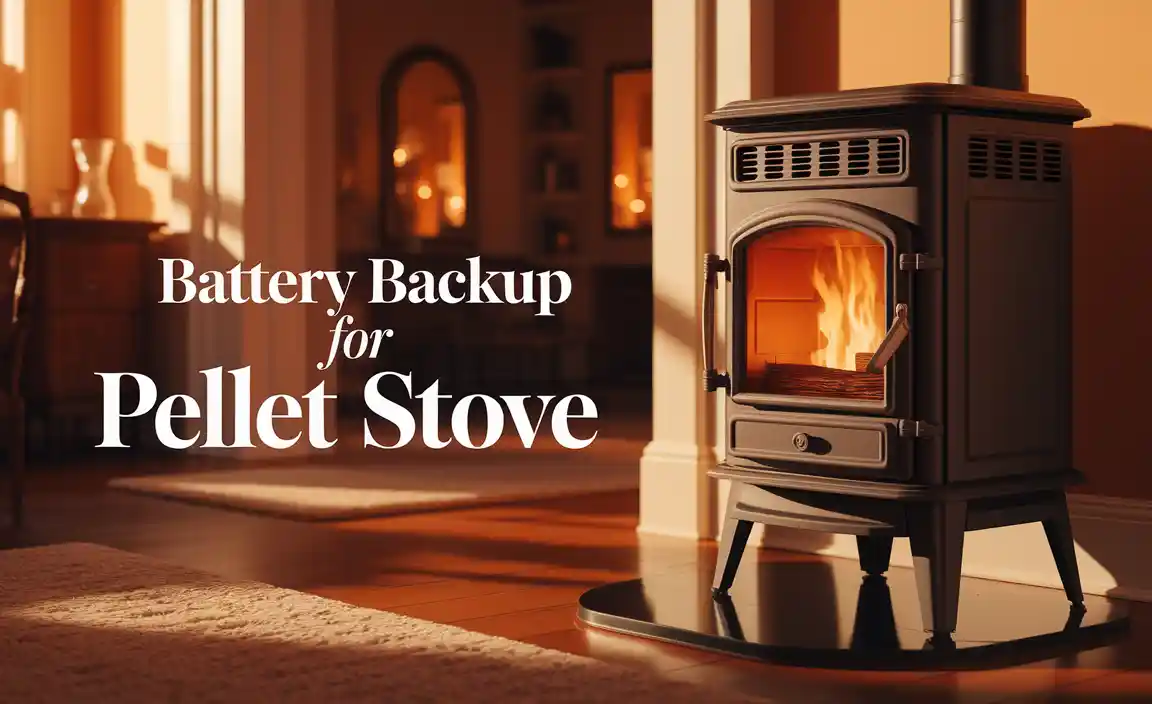The right battery for your Honda Accord is crucial for reliable starting and power. For most models, a Group Size 35 battery offers the perfect blend of size, power, and fit. Always check your owner’s manual or consult a professional to confirm the exact size and terminal configuration for your specific year and trim.
Driving a Honda Accord is a pleasure. They’re known for being reliable, comfortable, and efficient. But like any car, its heart depends on a healthy battery. A dead battery can leave you stranded, which is never fun. This guide is here to make choosing and understanding the “battery for a Honda Accord” simple, even if you’ve never looked under the hood before. We’ll walk you through everything you need to know, from picking the right one to keeping it in top shape.
Why Your Honda Accord Battery Matters
Your car battery is like the engine’s best friend. It provides the big burst of power needed to start the engine and also keeps your car’s electronics running when the engine isn’t on. Think headlights, radio, power windows, and all the fancy computer systems. When the battery gets weak or dies, all these things stop working. For a Honda Accord, a reliable power source is essential for its smooth operation.
Choosing the correct battery isn’t just about getting your car to start; it’s about ensuring all its systems function as they should. A common issue for drivers is uncertainty about which battery is the “proven” choice. This article aims to clear up that confusion, providing you with the knowledge to make an informed decision for your specific Honda Accord.
Understanding Battery Basics for Your Honda Accord
Before we dive into specific recommendations, let’s cover some battery basics. It’s not as complicated as it sounds!
Battery Size (Group Size): This is perhaps the most critical factor. Batteries come in different physical dimensions and terminal placements. The most common group size for many Honda Accord models is Group Size 35. This size is designed to fit neatly in the battery tray and ensures the cables reach the terminals easily. However, Honda has made Accords for many years, and occasionally, other sizes might be used. Always double-check your owner’s manual or look at your current battery.
Cold Cranking Amps (CCA): This rating tells you how much power the battery can deliver in freezing temperatures to start your engine. If you live in a cold climate, a higher CCA rating is a good idea.
Reserve Capacity (RC): This measures how long the battery can power your car’s accessories if the alternator fails. A higher RC means your lights and radio will work for longer without the engine running.
Terminal Type: Most car batteries have top-mounted terminals, but some might have side-mounted ones. Ensure the new battery matches the type your Accord uses.
The “Proven” Battery for Most Honda Accords: Group Size 35
When searching for a battery for a Honda Accord, you’ll often see Group Size 35 recommended. This size is a consistent performer for many Accord models across various years.
Why Group Size 35 is a Go-To Choice:
Physical Fit: It’s designed to fit most Honda Accord battery trays.
Terminal Placement: The positive and negative terminals are typically oriented correctly to allow your car’s battery cables to connect easily and safely.
Power Output: Batteries in this group size generally offer sufficient CCA and RC for typical Accord needs, especially in moderate climates.
Which Honda Accord Models Often Use Group Size 35?
While it’s always best to confirm, Group Size 35 is a common fit for many generations of the Honda Accord, including models from the late 1990s through the 2010s. This includes:
Fourth Generation (1990-1993)
Fifth Generation (1994-1997)
Sixth Generation (1998-2002)
Seventh Generation (2003-2007)
Eighth Generation (2008-2012)
Ninth Generation (2013-2017)
Important Note: This is a general guideline. Variations in trims, engine sizes, and specific model years can sometimes necessitate a different battery size. The most reliable way to know for sure is to consult your Honda Accord’s owner’s manual or physically check the battery currently in your car. If you’re unsure, a trusted auto parts store or mechanic can quickly identify the correct size for you.
Popular Battery Brands and What to Look For
There are many reputable brands that make excellent batteries for your Honda Accord. When choosing, consider these factors beyond just the brand name:
Warranty: A good warranty (e.g., 2-3 years free replacement) is a sign of a manufacturer’s confidence in their product.
Price: Batteries can range from $100 to $200+. Balance cost with features and warranty.
Reviews: Look for reviews that specifically mention the battery’s performance in similar vehicles or climates.
Here are a few well-regarded battery brands known for quality:
Optima: Known for their innovative spiral-cell technology, offering high performance and vibration resistance, though often at a premium price.
DieHard: A trusted name with a range of batteries, often offering good value and performance.
ACDelco: A General Motors brand that produces reliable batteries for a wide variety of vehicles.
Interstate Batteries: Widely available and known for their durability and good warranty support.
EverStart (Walmart brand): Often a budget-friendly option that provides decent performance for the price.
Table: Comparing Battery Features (General Guide)
| Feature | Value / Consideration | Impact on Your Accord |
| :—————— | :————————————————————- | :———————————————————- |
| Group Size | 35 (most common) | Crucial for physical fit and cable connections. |
| CCA | 500-750+ | Higher is better for cold starts. |
| RC (Reserve) | 90-120+ minutes | Longer runtime for accessories if alternator fails. |
| Warranty | 2-3 year free replacement highly recommended | Protects your investment against premature failure. |
| Type | Lead-Acid (standard), AGM (Absorbent Glass Mat) | AGM offers longer life, better vibration resistance, faster charging. |
| Terminal Type | Top Post (standard) | Must match your existing battery cables. |
When to Replace Your Honda Accord Battery
Car batteries don’t last forever. On average, they last 3-5 years. Here are signs it might be time for a new battery:
Slow Engine Crank: The most common sign. The engine sounds like it’s struggling to turn over.
Dimming Lights: Headlights or interior lights seem dimmer than usual, especially when the engine is off.
Clicking Sound: When you turn the key, you hear a rapid clicking noise instead of the engine cranking. This often means the battery is too weak to engage the starter.
Warning Light: The battery warning light (an icon resembling a battery) illuminates on your dashboard.
Old Age: If your battery is past its typical lifespan (3-5 years), it’s wise to get it tested, even if it seems fine.
Swollen Battery Case: This can indicate internal damage and is a safety hazard.
Testing Your Battery: Most auto parts stores offer free battery testing. They can tell you if your battery is holding a charge or if it’s time for a replacement.
How to Safely Replace Your Honda Accord Battery (DIY Guide)
Replacing a car battery is a manageable DIY task for many. Safety is paramount, so follow these steps carefully.
Tools You’ll Need:
Socket wrench set (with appropriate size sockets for terminal clamps and hold-down bracket)
Battery terminal cleaner brush or wire brush
Gloves (rubber or nitrile)
Safety glasses
Wrench or pliers for the hold-down bracket
Dielectric grease or petroleum jelly (optional, for terminals)
A friend to help (optional, but recommended)
Safety First!
Park on a level surface.
Turn off the engine and remove the key.
Wear safety glasses and gloves. Car batteries contain corrosive acid.
Avoid sparks or open flames. Batteries can release flammable hydrogen gas.
Ensure good ventilation.
Never let metal tools touch both terminals at the same time. This can cause a dangerous short circuit.
Step-by-Step Replacement:
1. Locate the Battery: In most Honda Accords, the battery is located under the hood, usually on one side of the engine bay.
2. Identify Terminals: Note which is the positive terminal (marked with a “+” sign and often a red cover) and which is the negative terminal (marked with a “-” sign and usually black).
3. Disconnect the Negative Terminal FIRST: Using your socket wrench, loosen the nut on the negative terminal clamp. Once loose, carefully lift the cable off the terminal. Move it aside so it cannot accidentally touch the terminal.
4. Disconnect the Positive Terminal SECOND: Now, loosen the nut on the positive terminal clamp. Lift the cable off and secure it away from the terminal.
5. Remove the Hold-Down Bracket: Most batteries are secured by a bracket at the base. This might involve a bolt or clamp. Use your wrench to loosen and remove this bracket. Keep track of its parts!
6. Lift Out the Old Battery: Batteries are heavy. Carefully lift the old battery straight up and out of the battery tray. If it’s difficult, ensure all connections and the hold-down are fully removed.
7. Clean the Tray and Terminals: Use a wire brush or battery terminal cleaner to remove any corrosion from the battery tray and your car’s cable clamps. Clean surfaces ensure a good connection.
8. Install the New Battery: Carefully lower the new battery into the tray, making sure it’s oriented correctly (positive and negative terminals in the right place).
9. Secure the Hold-Down Bracket: Reinstall the hold-down bracket to secure the new battery firmly in place.
10. Connect the Positive Terminal FIRST: Place the positive cable clamp onto the positive terminal of the new battery. Tighten the nut securely with your socket wrench.
11. Connect the Negative Terminal SECOND: Place the negative cable clamp onto the negative terminal. Tighten the nut securely.
12. Apply Dielectric Grease (Optional): A small amount of dielectric grease or petroleum jelly on the terminals can help prevent future corrosion.
13. Double-Check Connections: Ensure both clamps are tight and secure, and that neither cable can wiggle.
14. Start the Engine: Close the hood and start your Honda Accord. It should start up normally.
15. Dispose of the Old Battery Properly: Never throw an old car battery in the trash. Most auto parts stores and recycling centers accept them for free.
Beyond Car Batteries: Powering Your Devices
While the “battery for a Honda Accord” is our main focus, Roy Walker is all about reliable power for all your needs. Let’s briefly touch upon other common battery-related items:
Phone Batteries: These are often non-user-replaceable these days. When a phone battery degrades, you typically need to have it replaced by a professional or consider a new phone. Signs of a bad phone battery include rapid draining, the phone shutting off unexpectedly, or a swollen battery.
Phone Chargers: Using the correct charger for your device is important. While many USB chargers are interchangeable, using an underpowered charger can lead to slow charging, and an incompatible or faulty charger could potentially damage your phone or battery. Always look for reputable brands and ensure the charger’s output (voltage and amperage) is suitable for your device.
Power Banks: These portable chargers are lifesavers for keeping phones and other gadgets powered on the go. When choosing a power bank, consider its capacity (measured in mAh – milliampere-hours), which indicates how many times it can charge your devices. Also, look at the output ports (USB-A, USB-C) and the charging speed.
Troubleshooting Common Battery Issues
Sometimes, even with the right battery, you might encounter problems. Here are a few common scenarios:
Car Won’t Start, But Lights Come On: This often indicates a weak battery or a problem with the alternator not charging it. Test the battery and check its connections.
Corroded Terminals: White or bluish powdery buildup on the battery terminals is corrosion. It impedes the electrical connection. Clean it off using a battery cleaning brush and a mixture of baking soda and water.
Battery Dies Quickly: If your battery is relatively new but dies frequently, it could be a “parasitic draw” – something in your car is continuing to draw power even when the car is off. This requires professional diagnosis.
Alternator Issues: The alternator charges the battery while the engine is running. If it fails, the battery won’t recharge, and the car will eventually die. Symptoms include dimming lights when accelerating or a battery warning light.
Environmental Responsibility and Battery Recycling
Car batteries contain lead and sulfuric acid, which are harmful to the environment if not disposed of properly. It’s crucial to recycle them.
Take them back to the point of purchase: Most auto parts stores accept old batteries when you buy a new one.
Local recycling centers: Many municipalities have designated drop-off locations for hazardous waste, including car batteries.
Scrap metal yards: Some scrap yards will also take car batteries for recycling.
By recycling, you help recover valuable materials and prevent pollution. It’s a small step that makes a big difference. For more information on battery recycling, you can check resources from the Environmental Protection Agency (EPA) or local environmental agencies.
Frequently Asked Questions (FAQ)
Q1: How do I know if my Honda Accord needs a new battery?
A1: Common signs include your engine cranking slowly, dimming lights, a clicking sound when you try to start it, a battery warning light on the dashboard, or the battery being more than 3-5 years old.
Q2: What is the best battery group size for a Honda Accord?
A2: For most Honda Accord models, Group Size 35 is the standard and proven choice. However, always confirm this with your owner’s manual or by checking the current battery in your car, as variations exist by year and trim.
Q3: Can I use a different battery group size if mine isn’t available?
A3: It’s strongly recommended to stick to the specified group size. A different size might not fit correctly in the battery tray, or the terminal posts may not align with your car’s cables, leading to unsafe or improper connections.
Q4: How long should a new Honda Accord battery last?
A4: Under normal conditions, a good quality car battery typically lasts between 3 to 5 years. Climate, driving habits, and maintenance can affect its lifespan.
Q5: Is it safe for me to replace the battery myself?
A5: Yes, replacing a car battery is a common DIY task. However, it’s essential to follow safety precautions strictly, such as wearing protective gear and disconnecting the negative terminal first and connecting it last to avoid short circuits.
Q6: Where can I buy a replacement battery for my Honda Accord?
A6: You can purchase them at auto parts stores (like AutoZone, Advance Auto Parts), big-box retailers (like Walmart, Target), your local Honda dealership, or online from various automotive retailers.
Q7: What does “Cold Cranking Amps” (CCA) mean for my Accord battery?
A7: CCA is a rating that indicates how much power a battery can deliver in freezing temperatures (0°F or -18°C) to start your engine. If you live in a cold climate, a higher CCA rating is beneficial for reliable starts in winter.
Conclusion
Choosing the right battery for a Honda Accord doesn’t need to be a mystery. For most models, the Group Size 35 battery is your dependable, proven choice, fitting well and providing the necessary power. However, always taking that moment to double-check your owner’s manual or your current battery ensures you get an exact match.
We’ve covered the signs of a failing battery, the essential specifications to look for, and a safe, step-by-step guide to replacing it yourself. Remember, a healthy battery is key to your Accord’s reliable performance, keeping you moving smoothly on every journey.
Don’t forget that power extends beyond your car. Whether it’s keeping your phone charged with reliable chargers and power banks or understanding battery care for your devices, being informed makes managing your power needs simpler.
By staying mindful of your battery’s age, condition, and any troubleshooting tips, you can confidently maintain your Honda Accord and power your life on the go. Safe driving, and may your Honda Accord always start with confidence!





